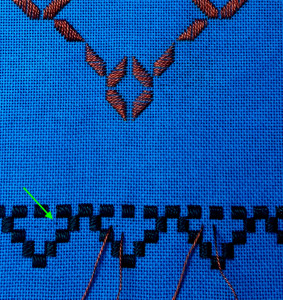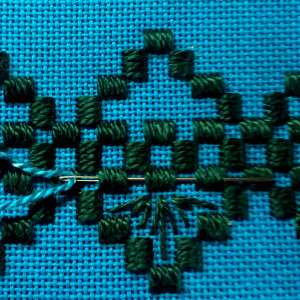Parking your thread
Parking is a term applied to handling/controling your stitching thread(s) when not in use.
The term parking is also used to indicate when you need to have the tail end of your thread held aside until you can secure (weave) it into a worked area.
In either case, you have a length of thread that you want to keep aside, away from the current stitching area.
In this photo I want to hold the tail end of several stitching threads of the Mahogany color thread aside until I get the chance to secure (weave) them in the stitched area on the back of the fabric. So I park those tail ends within the dark green kloster blocks in which I know I will be adding fill-in stitches as I finish the worked piece.When you remove parked threads it often leaves enlarged fabric holes so be sure to park your threads way out pass the design area or in an area of the fabric that will eventually be covered with stitches. I placed a neon green arrow on the photo to emphasized one of the enlarged fabric holes left when a parked thread was removed. As I mentioned above, I know in advance that these areas within the kloster blocks will eventually have fill-in stitches so holes left over by parked threads will be covered over.
Parking the needle
I only have threaded needles in play as I work, the rest are put away in a drawer (so I don’t lose an unthreaded needle).
I find it’s best not to stick the needle into the fabric when the needle is not in use. My preference is to have a large magnetic (one each side of the fabric) and place the unused threaded needle(s) there. If I am only working with one threaded needed (my norm), then when not in use I slip the needle into the work design (as shown below).
The reason I normally only work with one needle is I’ll find myself looping my working stitching thread around the tip of the parked needle or, even worse, find that I have knock the needle off of a parked thread and have to go searching about to find that needle in my chair or on the floor.


